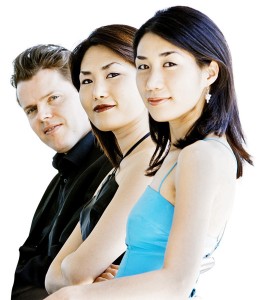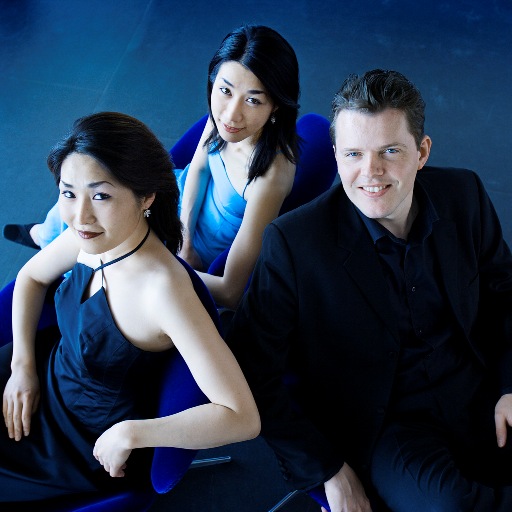Concert Review: A Superb Trio con Brio Copenhagen at Tuckerman Hall, Worcester
The extraordinary intensity the Trio con Brio Copenhagen achieved at soft dynamic levels and their very natural sense of the movement’s pacing were both quite impressive.
By Jonathan Blumhofer

Trio con Brio Copenhagen, from left: Jens Elvekjaer, Soo-Kyung Hong and Soo-Jin Hong. Photo: Soren Svendsen.
For a year that is only a few days old, 2012 is off to an auspicious start, musically. On Wednesday evening, Music Worcester presented the fine Trio con Brio Copenhagen at Tuckerman Hall in a program of piano trios by Haydn, Ravel, and Anton Arensky. The performance was both well attended and well played: this is an ensemble that is comprised of two sisters, Soo-Jin Hong (violin) and Soo-Kyung Hong (cello), and Soo-Kyung’s husband, Jens Elvekjaer (piano). With such a lineage, one would expect a high level of music making from the group, and, indeed, all three pieces on Wednesday’s program showcased moments of superb ensemble unity and sensitive musicianship, this latter quality exhibited both individually and corporately.
Haydn’s Trio in G major (Hob. XV: 25 “Gypsy”) is assumed to be one of the last composed of his 44 surviving works in the genre. Written in England in 1795, the piece falls into three movements, the first two on the slow side (marked Andante and Poco adagio, respectively) before the work concludes with a finale that utilizes authentic, Gypsy tunes Haydn had heard in Austria.
In Wednesday’s performance, the first movement—which consists of a theme and variations that alternate between the major and minor modes—was given a thoroughly characteristic (which is to say, songful) reading, with striking contrasts of mood between each section. The extraordinary intensity the ensemble achieved at soft dynamic levels and their very natural sense of the movement’s pacing were both quite impressive.
This nice sense of pacing continued into the even slower second movement, where piano and violin had solo turns. Throughout the evening, Mr. Elvekjaer remained more or less in the background, though he’s a marvelously sensitive pianist, and this movement brought out the poetic quality of his playing. Ms. Hong (Soo-jin) is a fine violinist with a particularly striking command of her upper register, though this movement allowed her to explore the warm, lyrical quality of her instrument’s lower strings.
In the “Gypsy” finale, one gets a hint of the material Brahms, Sarasate, and others would do so much with in the 19th century. In the context of Haydn’s musical language, it can be somewhat jarring to hear folk tunes like these following two slow, echt-Classical movements. In the Trio’s performance, though, the tunes were played with, well, brio (and this was especially true of their excursions into the minor mode). The first theme of this rondo-finale (which, per the form, recurs several times throughout the movement) is a brisk, unison melody for violin and piano, and Ms. Hong and Mr. Elvekjaer were perfectly together at every turn.
Ravel’s Piano Trio followed; thanks to Trio con Brio’s intelligent programming, this magisterial piece formed the emotional heart of the evening. This year marks the 75th anniversary of Ravel’s death, an occasion one hopes will be commemorated with the same vigor as Mahler’s big year was in 2011 and Wagner’s bicentennial surely will be next year. This Piano Trio, written as Europe hurtled towards the abyss in the summer of 1914, formed a more than welcome addition to Wednesday’s program.
The atmospheric first movement of the Trio allowed the ensemble to again showcase their sensitive pianissimo playing. I was particularly impressed with their reading of its final pages: underneath violin and cello harmonics, the piano repeats an ominous melodic figure, and Mr. Elvekjaer drew out the drama of this passage to fine effect.
According to our program notes, the form of the Trio’s second movement, Pantoum, is derived from a Malay verse form. Though I could have used some more volume from the piano in this movement, the strings—who throughout the piece often share melodic material separated by two or more octaves—shone in the movement’s high middle section. The whole ensemble made much of Ravel’s trippy rhythms and was fully caught up in the music’s spirit.
Following the high energy of the Pantoum comes a slow Passacaille that features 11 repetitions of an eight-bar phrase. The ensemble gave a well-paced reading that reached its apotheosis in the muted violin/cello duet towards the movement’s end. To conclude, the work’s vigorous finale was dispatched with bright trills and great enthusiasm, though, again, it might have been more effective had the group’s balance been tilted more in the piano’s favor.
Following intermission, Trio con Brio returned with Anton Arensky’s Piano Trio no. 1 in D minor. Arensky is not a widely known composer, though his career intersected with quite a few: he was a student of Rimsky-Korsakov, a colleague of Tchaikovsky, and the teacher of Rachmaninov and Scriabin (among others). The present Trio was written in 1894 and takes the first Mendelssohn Piano Trio as its model.
Its first movement follows a somewhat peculiar form, moving in tempo from allegro moderato to adagio, and it seems to channel Mendelssohn and Tchaikovsky in both its melodic material and contrapuntal writing. Several moments in its central section sound like pure Rachmaninov (or, perhaps more accurately, some Rachmaninov sounds like pure Arensky), and the Trio reveled in these long, lyrical melodic lines.
The impish second movement, Scherzo, is a raucous affair. It begins much like the Scherzo of Dvorak’s Sonatina (op. 100), where a short violin phrase is accompanied by the piano. Soon, though, the music becomes much more complex and fills with all sorts of unexpected twists, both instrumental effects (artificial harmonics, ricocheted bow strokes, etc.) and harmonic surprises. Throughout, Trio con Brio navigated the movement’s shifty character with agility and a good deal of humor.
Following the light-hearted Scherzo comes the darkly moving third movement, Elegia. Here each instrument has multiple solo opportunities, and all three players took advantage of theirs: particular praise should be given to Ms. Hong (Soo-Kyung) for her warmly shaped cello turns. The mid-section of this movement features some surprisingly delicate textures that on Wednesday seemed to foreshadow the later Ravel Trio; a return to the somber opening melody brings the movement to its close.
The finale moves between a vigorous opening theme and a lyrical, Tchaikovsky-like second melody; before the end, the opening material from the first movement returns to lead into an energetic coda in the minor mode. As they did throughout this piece, Trio con Brio made much of the contrasts of character in the movement and gave life to the music’s inherent drama. Arensky, who was a formidable concert pianist in his day, wrote a highly involved piano part in this Trio—particularly for these outer movements—and Mr. Elvekjaer was continually up to the challenge. The Hong sisters, too, didn’t miss a beat in the equally involved string parts.
To close the evening, the group provided one encore: the slow second movement of Mendelssohn’s Piano Trio no. 1 in D minor. It was exquisitely played. Since it’s impossible to single out individual performers to praise, I won’t. Suffice it to say, their combined sense of the music’s melodic shape was utterly convincing, and I found it highly unfortunate that the spell they wove at the end of the movement had to be broken by applause. Let’s have them back early and often.

